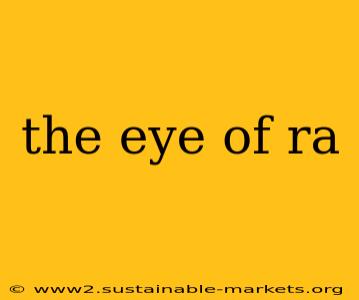The Eye of Ra, also known as the Eye of Horus, is one of the most enduring and powerful symbols in ancient Egyptian mythology. Far from being a simple image, it represents a complex interplay of divine power, protection, healing, and royal authority. This exploration delves into the rich history and multifaceted symbolism of the Eye of Ra, examining its evolution and continued relevance in modern culture.
Distinguishing the Eye of Ra and the Eye of Horus: A Necessary Clarification
While often used interchangeably, the Eye of Ra and the Eye of Horus are distinct, yet closely related, symbols. The Eye of Horus, often depicted as a single eye (either left or right, each with different attributed powers), symbolizes wholeness, protection, and royal power. It's associated with the god Horus, son of Osiris, and his triumph over his uncle Set. The Eye of Ra, however, is directly linked to the sun god Ra, representing his power, the sun's life-giving energy, and the ability to see all things. While both are often depicted similarly – a stylized human eye with distinctive markings – their mythological context significantly differs.
The Symbolism of the Eye of Ra: Power, Protection, and Royal Authority
The Eye of Ra is far more than a simple representation of sight. It embodies a constellation of powerful symbolic meanings:
The Sun's Power and Life-Giving Force:
As an aspect of Ra, the sun god, the Eye of Ra directly symbolizes the sun's life-giving energy. It represents the sun's daily journey across the sky, bringing light, warmth, and sustenance to the world. Its destruction and rebirth represent the cyclical nature of life and death, as well as the constant renewal of the sun's power.
Divine Protection and Vengeance:
The Eye of Ra is also frequently portrayed as a powerful weapon, capable of inflicting vengeance on Ra's enemies and protecting him from harm. This aspect reflects the sun's overwhelming power and its ability to destroy darkness and chaos. In amulets and funerary rituals, it served as a potent symbol of protection for the deceased in the afterlife.
Royal Authority and Divine Kingship:
In ancient Egypt, pharaohs were considered divine rulers, directly connected to the gods. The Eye of Ra, as a symbol of divine power, was closely associated with the pharaoh's authority and legitimacy. It frequently adorned royal regalia and monuments, reinforcing the pharaoh's role as a divinely appointed ruler.
The Eye of Ra in Ancient Egyptian Art and Religion
The Eye of Ra is ubiquitous in ancient Egyptian art and religion. Its representation varies slightly depending on the context and the artist's stylistic choices, but its core symbolism remains consistent. One can find the Eye of Ra prominently featured in:
- Wall paintings and tomb decorations: Illustrating mythological narratives and emphasizing the protection offered to the deceased.
- Amulets and jewelry: Worn as personal talismans for protection and good fortune.
- Statues and sculptures: Further reinforcing the divine power and authority of the pharaohs.
- Hieroglyphics: Used as a symbolic representation in texts related to religion, mythology, and royalty.
The Eye of Ra's Enduring Legacy: From Ancient Egypt to Modern Interpretations
Despite its origins in ancient Egyptian civilization, the Eye of Ra continues to hold significance in modern contexts. Its powerful imagery resonates with many individuals, who adopt it as a symbol of:
- Protection and warding off evil: Its enduring association with protection maintains its appeal as a personal talisman.
- Inner strength and resilience: Overcoming adversity mirrors the sun's cyclical journey of destruction and renewal.
- Spiritual enlightenment and self-discovery: The "all-seeing" aspect of the eye speaks to introspection and awareness.
- Connection to ancient wisdom and mysticism: The Eye of Ra serves as a powerful link to a rich and captivating history.
The Eye of Ra, a potent symbol steeped in ancient Egyptian mythology, continues to fascinate and inspire. Its lasting legacy lies not only in its visual appeal but also in the rich tapestry of symbolism it represents – a powerful reminder of divine power, protection, and the eternal cycle of life, death, and rebirth.

